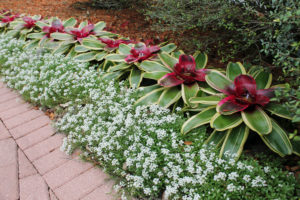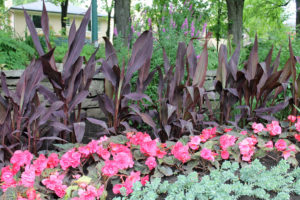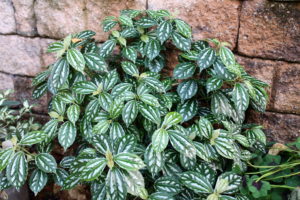Tropicals for the Summer Landscape
May 28th, 2019
The heat and humidity of a typical Harrisburg August is enough to make it seem as if we’re living in the tropics.
If that’s the case, we may as well grow with the flow.
Plenty of tropical plants do nicely here as summertime in-ground, landscape plants.
They think they’re at home.
Yet we limit our use of tropicals to houseplants or, at best, in summer pots alongside the petunias and geraniums.
Hardly anyone here sticks a croton or a copper plant in the ground.
Actually, most so-called “houseplants” grow well in our May-to-September landscapes.
Two caveats:
1.) If you plan to keep tropicals more than one season, you have to dig them and pot them for inside storage once the late-season temperatures dip into the low 40s.
Frosts and near frosts will kill most tropical natives. But most are up to double-duty as winter houseplants before going back outside the following May.
Note: Hose off or spray your tropicals after repotting so you don’t take bugs into the house.
2.) Be careful about light. Even a tropical that prefers full sun can wash out in color or drop leaves if it goes directly from inside to full sun outside.
The solution is to acclimate the plant to increasing outside light over a 7- to 10-day period or to plant it outside in shade or part shade.
Tropicals appreciate going into warm, real soil where their roots are free to roam. You may notice them thrive like never before.
Life in a pot is stunting. Species sold as houseplants are good at tolerating that, but none of them prefer it.
Nonetheless, if you’d rather not unpot and plant tropicals, go ahead and sink them pots and all. At least it’ll cut down on how often you have to water compared to potted tropicals sitting on the deck or porch.
So where do you get these tropicals?
Start by looking in the garden center’s houseplant section. This is where you’ll find such species as peace lilies, Chinese evergreens, and snake plants that really are common landscape plants in their home lands.
Second, look in the annuals section – especially the 4- to 6-inch potted plants that are intended mainly as centerpiece plants for summer pots. This is where you’ll find the age-old “spike plants” (Dracaena) as well as more cutting-edge ti plants (Cordyline), New Zealand flax (Phormium), and tender ornamental grasses.
A third source is catalog companies that specialize in tropicals. Two good ones are Connecticut-based Logee’s Greenhouses and Louisiana-based Stokes Tropicals.
One of the best uses for tropicals in the landscape is as a specimen or focal point. Even just one tropical hibiscus or palm in a bed of annuals or low perennials can make a dramatic difference.
Look for plants that grow bigger and more upright for this situation, especially ones with colorful leaves or interesting textures.
In sun, good examples are crotons and copper plants. Both grow into bushy shrubs with bright red, gold and green leaves.
Century plants (Agave) and bromeliads make excellent eye-grabbers with their strappy, succulent upright forms.
And nothing cries out for attention more than elephant ears or banana plants. Both have huge leaves about the size and look of, well, an elephant’s ear. Red-leafed bananas add showy color to their sheer giganteousness.
While you’re at it, save a poinsettia or two this Christmas. Although they don’t stay bright red, they do produce new green tropical-looking foliage on 3- to 4-foot bushes when planted in the ground for summer.
In shade, look to houseplants that serve as good choices for low-light conditions.
These include peace lilies, dieffenbachia, jade plant, Chinese evergreens, and schefflera. Two others that are particularly nice are chenille plants with their hanging, fuzzy flowers and breynia, a bushy plant with beautiful pink, white and green leaves.
All of these are substantial enough to lord over your 1- and 2-foot bed plantings.
Another overlooked use for tropicals is as summertime shady groundcovers.
I see a lot of bare mulch under trees and tall shrubs – probably because dry-shade settings are difficult challenges for most plants and because our choices in low, shade-happy annuals are few (primarily begonias, impatiens and coleus).
In the tropics, plenty of plants grow as under-tree creepers.
For us, philodendron is a common indoor basket plant, but in its homeland, it’s a shady landscape groundcover.
Ditto for pothos, wandering jew, purple heart (Setcreasea), moses-in-a-boat (Tradescantia), and aluminum plant (Pilea).
All of those are low-care, colorful, shady, summer-groundcover options that turn into living-room pot and basket plants in winter.
Steamy weather calls for steam-happy plants. And if most of them are willing to tolerate our dark, dry living rooms in winter, too, so much the better.










